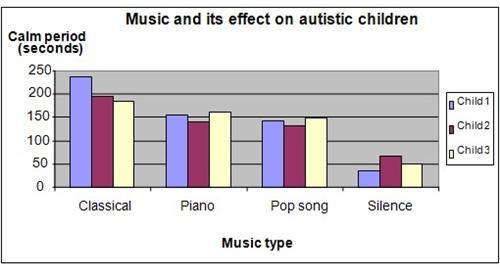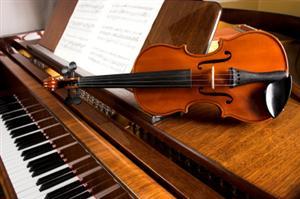| Complexity level: | 9 |
| Project cost ($): | 20 |
| Time required: | 1 hour to prepare, 4 days for science fair project |
| Material availability: | Participation of autistic children |
| Safety concerns: | None |
Hypothesis
Autistic children will be more relaxed and calm when music is played in the background.
Overview
Autism and music
Autism is a condition caused by a disorder in the neural development. The symptoms of autism are the inability to interact socially, being unable to speak or communicate properly and repetitive behavioral patterns. These symptoms normally surface in children who suffer from autism by the age of three.
Music therapy has been found to be beneficial to children with autistic conditions as it does not involve verbal communication. Music therapy has been found to be especially effective in the remediation and development of speech among autistic children. Some autistic children are able to sing even though they cannot speak.
Another observation is that autistic children are sensitive to music. They often are able to play musical instruments.
Scientific Terms
Materials
The materials required for the science project experiment:
- 3 autistic children aged 10 to 12 years old
- Approval of their parents to have the them involved in in this science project
- 1 classical music CD
- 1 piano instrumental music CD
- 1 pop song CD
- 1 CD player
- 1 stopwatch
Procedure
1. For this science fair project, the independent variable is the type of music played – classical music, piano instrumental music or pop songs. The dependent variable is the length of time the child is able to sit and be relaxed. This is determined by using a stopwatch to record the time the autistic child remains calm. The constants (control variables) are the age of the children, the gender of the children and the environment of the room used for testing.
2. Permission is first obtained from the parents of the 3 autistic children.
3. On the 1st day of the science fair project, the autistic children will be tested with the classical music. The first child to be tested is brought into the room used for testing and given some time to adjust and sit comfortably. The classical music is played on the CD player for 15 minutes and the autistic child is observed. The longest period of time the child is able to sit relaxed while the music is being played is taken with a stopwatch and recorded in the table given below.
4. Procedure 3 is repeated on the second and third child. The longest time they are able to sit calmly while the music is being played for 15 minutes is recorded in the table below.
5. Procedures 3 and 4 are repeated using piano instrumental music or pop songs on the second day and third day.
6. On the fourth day, the 3 autistic children are made to sit in the same place for 15 minutes without any music and the length of time they are able to sit relaxed is noted and recorded in the table given below.

Results
The results showed that the autistic children were able to relax longer when music being played in the background. They were able to remain calm the longest when classical music was played .
|
Length of time the child was relaxed when music was played (seconds) |
||||
|
Classical |
Piano |
Pop song |
Silence |
|
|
Child 1 |
237 |
154 |
143 |
35 |
|
Child 2 |
194 |
139 |
131 |
67 |
|
Child 3 |
183 |
163 |
147 |
49 |
The graph below represents the results of our science project experiment.

Conclusion
The hypothesis that autistic children will be more relaxed and calm when music is played in the background, is proven to be true.
Autism is a neurological disorder where the brain’s normal functions are adversely affected. The symptoms normally appear during early childhood and continue through a person’s adulthood. Currently there is still no known cure for this condition. However, music therapy has been accepted and used on autistic persons since the 1950’s.
Also consider
To improve the reliability and accuracy of our results, a larger sample of participants should be used.
This science fair project may be repeated, using different types of music like rock, jazz or country.
Modify the science project experiment, by trying to have the children sing or produce other reactions .
References
Autism - http://en.wikipedia.org/wiki/Autism
Music Therapy and Language for the Autistic Child - http://www.autism.com/families/therapy/music.htm
Autism Disorder - Music therapy could bring about a Significant Change - http://www.alternateheals.com/music-therapy/autism-music-therapy.htm

